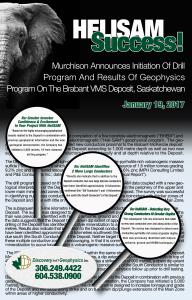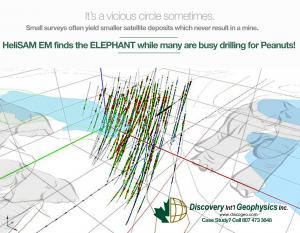HeliSAM Finds Another Elephant!
Murchison Minerals Confirm Program Based on HeliSAM Survey Success.
SASKATOON, SASKATCHEWAN, CANADA, January 26, 2017 /EINPresswire.com/ -- January 19, 2017Murchison Announces Initiation Of Drill Program And Results Of Geophysics Program On The Brabant VMS Deposit, Saskatchewan
Murchison Minerals Ltd. -- January 19, 2017 (CSE -- MUR) ("Murchison" or the "Company") is pleased to report that the Company is planning a minimum 10-hole, 5,000 metre diamond drilling program, to begin in February of this year, on its wholly owned Brabant-McKenzie zinc--copper property located near the community of Brabant Lake, Saskatchewan, 175 kilometres northeast of La Ronge Saskatchewan. The drill program follows the recent completion of a five borehole electromagnetic ("BHEM") and low-level helicopter borne, B Field electromagnetic ("Heli-SAM") geophysical program. The geophysics surveys successfully identified new conductors proximal to the Brabant-McKenzie deposit (the "Deposit"), coincident with the Deposit extending to 1,000 metre depth as well as two new significant electromagnetic conductors located laterally and at depth relative to the Deposit.
The Deposit is described as a high-grade sphalerite-chalcopyrite-pyrrhotite rich volcanogenic massive sulfide ("VMS") occurrence which hosts a NI 43-101 indicated resource of 1.6 million tonnes grading 9.2% zinc and an inferred resource of 3.0 million tonnes grading 5.6% zinc (MPH Consulting Limited and P&E Consultants Inc.; dated September 12, 2008, the "Technical Report").
The drill program is based on the newly acquired BHEM and Heli-SAM data coupled with a new geological interpretation of the Deposit.
The BHEM surveys focused on the periphery of the upper and lower main mineralized zones (together the "Main Zone") of the Deposit. The survey was successful in identifying numerous conductive electromagnetic plates that are coincident with thicker zones of the Deposit and areas with little or no testing by previous drilling immediately adjacent to the Main Zone.
The subsequent 120-line kilometre Heli-SAM survey was conducted over and along strike of the Deposit. The survey was designed to detect more conductive pyrrhotite rich zones at greater depths than was previously identified with historic airborne, ground and BHEM techniques. Interpretation of the data suggests that the Deposit has a down dip extent of approximately 1,000 metres while historic drilling of the Deposit has identified VMS style mineralization to a current down dip depth extent of 520 metres. Results also indicate that in addition to the Deposit conductor, two new large discrete conductors have been identified approximately 1.5 kilometres southwest (the "SW Conductor") and 1.4 kilometres due south (the South Conductor") of the Deposit. Neither target has been drill tested. The clustering of these multiple conductive zones is encouraging, in that it is common for several zones of stratabound mineralization to occur locally within a volcanogenic massive sulfide setting.
The SW Conductor is believed to be located within the same stratigraphic host rock as the Deposit. Modeling indicates a strike length of 1.4 kilometres, a dip extent of 600 metres and a depth to top of 490 metres. Modeling of the South Conductor indicates a strike length of 900 metres, a down dip extent of 300 metres and a depth to top of 600 metres. The conductivity of the South Conductor is similar to the Main Zone. Both targets will require additional ground geophysics follow up prior to drill testing.
Based on the highly encouraging geophysical results related to the Deposit in combination with previous geophysical information and the new geological interpretation, the Company has initiated a 5,000 metres, 10-hole diamond drilling program. The drill program is designed to increase tonnage and grade of the Deposit and will focus along strike and on the down dip/plunge extensions of the Main Zone within areas of higher conductivity.
The Company has received land and water permits for this phase of exploration and has awarded the drill contract. The Drill Program is expected to take approximately six weeks to complete.
Qualifying Statement
Graham Gill, P.Geo. and Martin St. Pierre, P. Geo., qualified persons as defined by National Instrument 43-101, were responsible for the design of the geophysical program and have approved the scientific and technical disclosure in the news release.
About Murchison Minerals
Murchison Minerals Ltd. is a Canadian based exploration company with a diversified portfolio of properties, including the Brabant-McKenzie Zinc-Copper deposit in north-central Saskatchewan, the HPM Nickel/Copper/Cobalt project in Quebec. Murchison also holds gold claims in the Pickle Lake area of northwestern Ontario.
Additional information about Murchison Minerals and its exploration projects can be found at www.murchisonminerals.com.
For further information, please contact:
Kent Pearson, President and Chief Executive Officer
info@murchisonminerals.com
(416) 350-3776
Discovery Geophysics offers the HeliSAM service and can be reached at 306.249.4422. See more on this topic on our Linked In broadcast.
Kevin Palmer
Discovery Geophysics
807 473 3648
email us here



